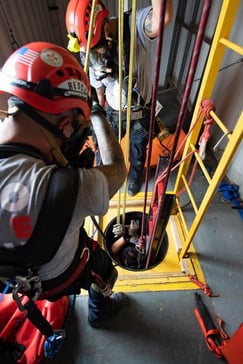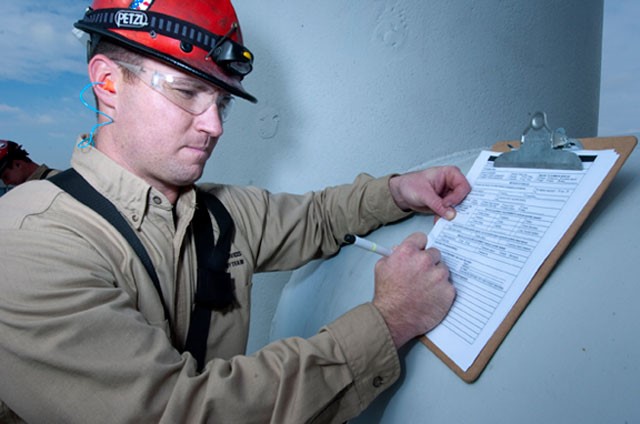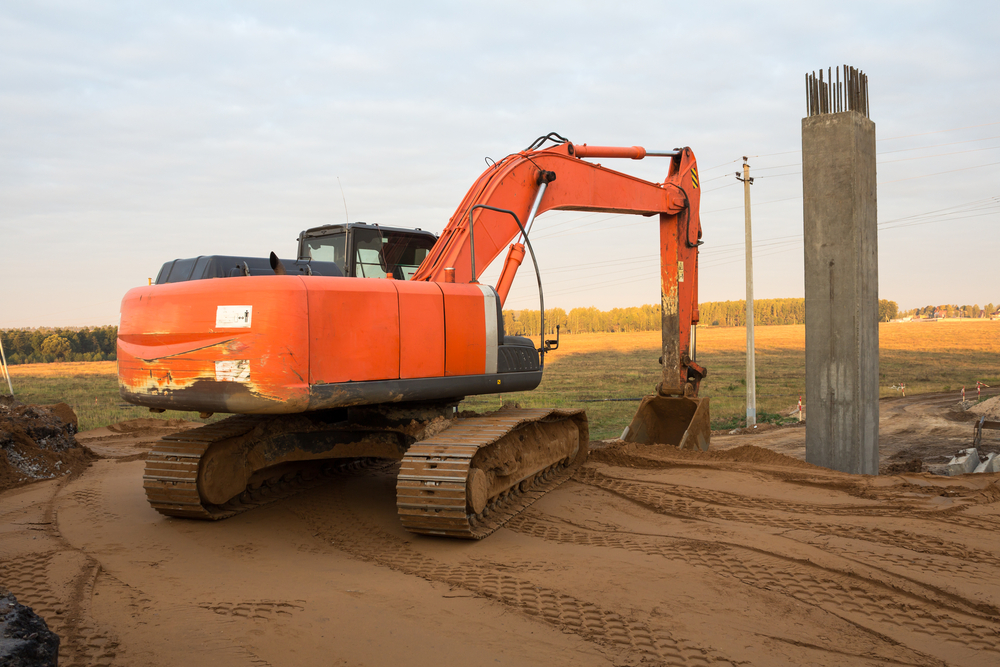Tim Robson’s involvement with trench rescue started in 1994 when his technical rescue team from the Albuquerque Fire Department responded to what the dispatcher called a trench event.
“When we arrived on the scene, no one was there other than a police officer and a grandmother,” Tim recalls. “She couldn’t find her grandson.”
A company doing trench work in front of her home had offered to pay the woman’s teenage grandson hourly to help them. The teenager was inside the trench when it collapsed.

“The company left, and they left him in the trench,” Tim explains. “Unfortunately, it was a fatality. When we found him, he had already succumbed.”
As a result of that experience, Tim understands firsthand the risks involved in trench work and the importance of trench safety. Now, Tim supervises Roco Rescue’s technical rescue teams across the globe and, as a Chief Instructor, leads training courses in – among other things – trench rescue.
Tim is presenting a course on “Managing Excavations” at the North Dakota Safety Council’s 46th Annual Safety & Health Conference later this month. We sat down to talk with Tim recently to find out more about trench safety and why it’s so important.
Roco Rescue: Good afternoon, Tim, and thank you for talking with us today about trench/excavation safety. Let’s start with the overarching question: How dangerous is trench work?
Tim: Trenching/excavation is one of the major fatality-causing occupations in the U.S. right now, according to the Bureau of Labor Statistics. Of the 130 trench/excavation fatalities that occurred between 2011 and 2016, 80% of those occurred in the private construction industry.
What scares us even more is that the number of fatalities is trending up. In 2014, there were 13 fatalities in trench/excavation. In 2015, that number rose to 25. And in 2016, there were 36 fatalities. So nearly half of the fatalities that occurred over a fifteen-year period happened in 2015 and 2016. Despite the fact that the regulations have gotten stricter, the numbers are trending up.

Roco Rescue: We’re going to touch on the OSHA regulations in a moment. First, please explain why the number of fatalities is trending upwards.
Tim: The increase in fatalities goes hand in hand with the uptick in employment and construction; as the economy improves, there’s more construction and, with that, more trenching and excavation.
In addition to more construction, there’s less space. As a country, we’re building more roads, more buildings, and more infrastructure but we have less physical space to do it in.
And in addition to doing more construction in less space, in our world, we have to do more with less. Ten years ago, there were six people working on a construction trenching job; today, there are 4, and that naturally lends itself to more safety violations.
Roco Rescue: What makes trenches so dangerous?
Tim: First, let me explain the difference between a trench and an excavation: an excavation is wider than it is deep, meaning there’s less chance of dirt collapsing because the vertical walls of the trench are sloping. If my wall slopes away from the bottom of the hole I dug, there’s less chance of that wall falling in.
A trench, on the other hand, is deeper than it is wide. If I have to dig a trench with a perfectly vertical wall, because there’s a road right next to where I’m digging the trench, I can almost guarantee a collapse.
To give readers an idea of the physics and mechanics involved when soil collapses, I often use this analogy: A typical collapse involves a couple of yards of dirt. A couple of yards of dirt collapsing into a 6-foot deep trench has the same force as a pickup truck moving 45 miles an hour. If you’re at the bottom of the trench and the soil falls in on you from 6 feet, you’re getting hit with the same amount of force as a pickup truck traveling 45 miles per hour.
When that force hits you, you can’t survive. And that’s just the force. There’s also the compression and blocked airways that the victim experiences. Every time you take a breath, the soil gets closer to your body so now it’s compressing you and you’re not able to expand your chest wall.
That’s why this is such a big concern for OSHA.
Roco Rescue: Let’s talk more about the OSHA regulations. What is OSHA doing to help reduce the number of fatalities caused by trench collapse?
Tim: Last year, OSHA put out a compliance letter urging the construction industry to improve the safety of their trenching and excavation operations.
OSHA requires that any time someone makes an excavation or trench in the ground as part of their occupation, they have to designate what’s called a competent person. That’s usually someone in a management or supervisory position who is tasked with “identifying existing and predictable hazards in the surroundings, or working conditions which are unsanitary, hazardous, or dangerous to employees, and who has authorization to take prompt corrective measures to eliminate them.”
Roco Rescue: Besides designating a competent person, what precautions can supervisors take at work sites to reduce trench injuries/fatalities, and what can workers do to keep themselves safe?

Tim: Construction businesses have to meet the OSHA requirements for trench and excavation safety. To make the trench safe takes more time, more manpower and more labor. Ultimately, safety costs money, which is a challenge for small business in particular.
But the implications for failing to meet the requirements comes with an even bigger cost. Worker safety notwithstanding, the Department of Labor and the Department of Justice now agree that if a fatality occurs on a job site due to a willful violation of an employer, it is now a criminal act.
However, workers are equally responsible for their safety. They are also accountable for their actions. If a trained worker willfully gets into that trench, knowing it’s unprotected, they’re just as culpable as the company that put them there.
In short, the employer’s responsibility is to make sure individuals are trained at work and the employee’s responsibility to understand and follow those requirements.
Roco Rescue: What are three things attendees at your upcoming course at the NDSC Annual Conference can expect to take away from your presentation?
Tim: First, don’t take trench and excavation lightly. There’s a risk that comes with saying, “We’ve always done it this way.”
Second, they’ll leave with an understanding of OSHA’s trench/excavation competent person requirements.
Third, they’ll understand the requirements of AHJ (the authority having jurisdiction), which is generally the host employer. The AHJ is the entity that must deem someone a competent person. As an instructor, I don’t have that authority. Taking my class doesn’t qualify someone as a competent person.
Roco Rescue: How will the course you’re giving at the NDSC Annual Conference differ from Roco Rescue’s training courses in trench rescue?
Tim: At the Roco Training Center, we offer open enrollment courses in trench rescue and can even do a private training based on a specific industry. Our courses teach how to construct a trench so that it won’t collapse and, if it does collapse because of some catastrophic event, teaches workers ways to protect themselves.
Both the courses at the Roco Training Center and my course at the NDSC Annual Conference are focused on compliance, but the course at the NDSC is geared toward a broader audience.
Roco Rescue: What’s your final piece of advice for trench workers, Tim?
Tim: It’s simple: until you know it’s safe, don’t get in the trench.
Roco Rescue: Thank you so much for sharing your knowledge and expertise with us, Tim.
For more information about Roco Rescue’s open enrollment or private training courses in trench safety and trench competent person, check out our training options.

 Refineries, plants and manufacturing facilities have a wide range of permit-required confined spaces – some having only a few, while others may have hundreds. Some of these spaces may be relatively open and straightforward while others are congested and complex, or at height. With this in mind, are all your bases covered? Can your rescue team (or service) safely and effectively perform a rescue from these varying types of spaces? Or, are you left exposed? And, how can you be sure?
Refineries, plants and manufacturing facilities have a wide range of permit-required confined spaces – some having only a few, while others may have hundreds. Some of these spaces may be relatively open and straightforward while others are congested and complex, or at height. With this in mind, are all your bases covered? Can your rescue team (or service) safely and effectively perform a rescue from these varying types of spaces? Or, are you left exposed? And, how can you be sure?



 Of course, the security of the system's attachment to the crane and the ability to “lock-out” any potential movement are a critical part of the planning process. If powered industrial equipment is to be used as a high-point, it must be treated like any other energized equipment with regard to safety. Personnel would need to follow the Control of Hazardous Energy [Lockout/Tagout 1910.147]. The equipment would need to be properly locked out – (i.e., keys removed, power switch disabled, etc.). You would also need to check the manufacturer’s limitations for use to ensure you are not going outside the approved use of the equipment.
Of course, the security of the system's attachment to the crane and the ability to “lock-out” any potential movement are a critical part of the planning process. If powered industrial equipment is to be used as a high-point, it must be treated like any other energized equipment with regard to safety. Personnel would need to follow the Control of Hazardous Energy [Lockout/Tagout 1910.147]. The equipment would need to be properly locked out – (i.e., keys removed, power switch disabled, etc.). You would also need to check the manufacturer’s limitations for use to ensure you are not going outside the approved use of the equipment. This is where the employer must complete written rescue plans for permit-required confined spaces and for workers-at-height using personal fall arrest systems – or they must ensure that the designated rescue service has done so. When developing rescue plans, it may be determined that there is no other feasible means to provide rescue without increasing the risk to the rescuer(s) and victim(s) other than using a crane to move the human load. These situations would be very rare and would require very thorough documentation. Such documentation may include written descriptions and photos of the area as part of the justification for using a crane in rescue operations.
This is where the employer must complete written rescue plans for permit-required confined spaces and for workers-at-height using personal fall arrest systems – or they must ensure that the designated rescue service has done so. When developing rescue plans, it may be determined that there is no other feasible means to provide rescue without increasing the risk to the rescuer(s) and victim(s) other than using a crane to move the human load. These situations would be very rare and would require very thorough documentation. Such documentation may include written descriptions and photos of the area as part of the justification for using a crane in rescue operations. Of course, one of the most important considerations in using any type of mechanical device is its strength and ability (or inability) to “feel the load.” If the load becomes hung up on an obstacle while movement is underway, serious injury to the victim or an overpowering of system components can happen almost instantly. No matter how much experience a crane operator has, when dealing with human loads, there is no way he can feel if the load becomes entangled. And, most likely, he will not be able to stop before injury or damage occurs.
Of course, one of the most important considerations in using any type of mechanical device is its strength and ability (or inability) to “feel the load.” If the load becomes hung up on an obstacle while movement is underway, serious injury to the victim or an overpowering of system components can happen almost instantly. No matter how much experience a crane operator has, when dealing with human loads, there is no way he can feel if the load becomes entangled. And, most likely, he will not be able to stop before injury or damage occurs.  Most often, training programs treat the three functions as separate, independent roles locked into a hierarchy based on the amount of information to be provided. However, it’s critical to note, if any one of these individuals fails to perform his or her function safely or appropriately, the entire system can fail – resulting in property damage, serious injury or even death in a confined space emergency.
Most often, training programs treat the three functions as separate, independent roles locked into a hierarchy based on the amount of information to be provided. However, it’s critical to note, if any one of these individuals fails to perform his or her function safely or appropriately, the entire system can fail – resulting in property damage, serious injury or even death in a confined space emergency. In my opinion, depending exclusively on the Entry Supervisor is faulty on a couple of levels. First of all, the amount of blind trust that is required of that one person. From the viewpoint of an Entrant, do they really have your best interest in mind? And, we all know what happens when we “ass-u-me” anything! Plus, it puts the Entry Supervisor out there on their own with no feedback or support for ensuring that all the bases are covered correctly. There are no checks and balances, and no team approach to ensuring safety.
In my opinion, depending exclusively on the Entry Supervisor is faulty on a couple of levels. First of all, the amount of blind trust that is required of that one person. From the viewpoint of an Entrant, do they really have your best interest in mind? And, we all know what happens when we “ass-u-me” anything! Plus, it puts the Entry Supervisor out there on their own with no feedback or support for ensuring that all the bases are covered correctly. There are no checks and balances, and no team approach to ensuring safety. Many times, we find that the role of Attendant is looked upon as simply a mandated position with few responsibilities. They normally receive the least amount of training and information about the entry. However, the Attendant often serves as the “safety eyes and ears” for the Entry Supervisor, who may have multiple entries occurring at the same time. In reality, the Attendant becomes the “safety monitor” once the Entry Supervisor okays the entry and leaves for other duties. So, there’s no doubt, the better the Attendant understands the hazards, controls, testing and rescue procedures – the safer that entry is going to be!
Many times, we find that the role of Attendant is looked upon as simply a mandated position with few responsibilities. They normally receive the least amount of training and information about the entry. However, the Attendant often serves as the “safety eyes and ears” for the Entry Supervisor, who may have multiple entries occurring at the same time. In reality, the Attendant becomes the “safety monitor” once the Entry Supervisor okays the entry and leaves for other duties. So, there’s no doubt, the better the Attendant understands the hazards, controls, testing and rescue procedures – the safer that entry is going to be!


